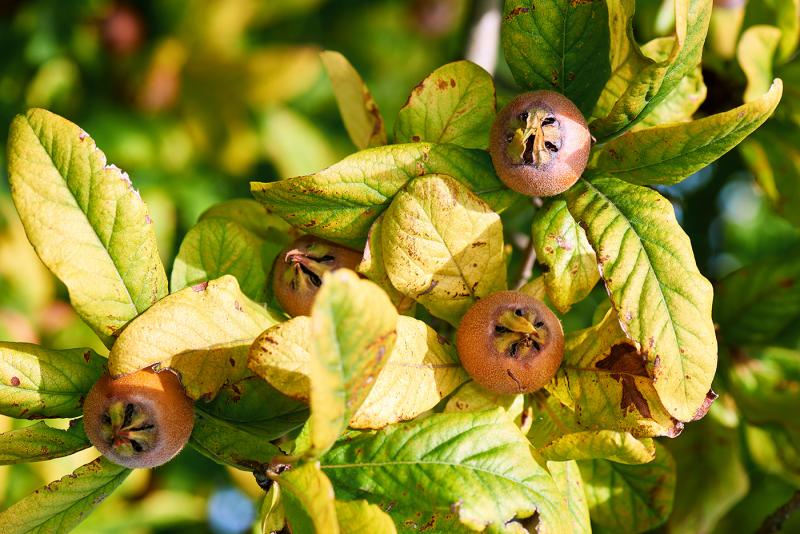
It is fall and time to gather fruit that has been nipped by frost. Some fruits need frost to improve their taste. The medlar (Mespilus germanica) is a small tree that is often grown in a shrub form. It bears fruit in late fall and early winter. Like apples, it is a member of the rose family, and medlar fruits look like large rose hips. The fruit tastes like applesauce or apple butter, with hints of vanilla and cinnamon.
Medlars bloom in late spring or early summer. The flowers are single white, about 2 1/2 inches wide, with five wide sepals and five petals. The fruits are inch-long, globe-shaped, dark red or brown.
Medlars are perfect winter fruits, because after they ripen in late autumn, they need some time to “blet.” Bletting a medlar is similar to how a persimmon ripens. It can happen naturally, by leaving the fruit on the tree through a few touches of frost, or you can blet the fruit in storage. To do that, pick the fruits in mid-November and store them in a cool area for 3-4 weeks. The colder you store them, the quicker they’ll soften up. You can even place medlars in the freezer to mimic bletting outdoors by frost.
Once softening begins, the skin quickly becomes wrinkled; it turns deep mahogany brown when they are ready to eat. The inside softens to the consistency and flavor of applesauce or apple butter, with hints of cinnamon and vanilla. They are ready to eat when they smell like apples.
Medlar fruits can be eaten fresh but usually are made into gooey jelly, candied fruit, jam, marmalade and even a sweet dessert syrup. Oddly, as a dessert, medlars are often served with cheese.
Because of the bletting process, medlars have gone out of fashion. No other common fruit has this ripening process, and many modern consumers are intimidated by it, thinking it is somehow rotten.
Medlars are native to the Middle East and southeastern Europe. They were brought to England by the Romans, and have been popular in English gardens ever since. Medlar branches are gnarled and brittle, so they make good firewood.
Great writers such as Shakespeare and Chaucer used medlars to convey the loss of womanly virtue. Medlar fruits were often used in plays as an analogy to old age, or a character with a rotten personality.
The two most popular varieties of medlar are Royal and Nottingham; they are also the two most widely available. Nottingham received the Royal Horticultural Society’s Award of Garden Merit. Medlars are self-pollinating, so you will get fine crops with a single tree.
The best time to plant any trees is in autumn. Dig a large hole that will easily fit the rootball. Place a sturdy stake to keep the medlar from twisting in the wind. There is no need to fertilize the tree for a year or two.
This tree can reach about 26 feet tall but is usually pruned to stay much shorter or even grow as a large shrub. Medlars normally require pruning just to keep them small or to shape the branches. Prune trees in midwinter when they are dormant. Medlars will live and bear fruit for 30-50 years.
Plant a medlar tree, and you will soon have a unique conversation piece and a semi-tropical tree that will give you cozy jams and jellies for a cold winter night.
"fruit" - Google News
September 15, 2022 at 05:04AM
https://ift.tt/8WtwEkx
Medlar is an ugly fruit with a lovely flavor - CapeGazette.com
"fruit" - Google News
https://ift.tt/La1Aqbg
https://ift.tt/SoChIJZ
Bagikan Berita Ini














0 Response to "Medlar is an ugly fruit with a lovely flavor - CapeGazette.com"
Post a Comment